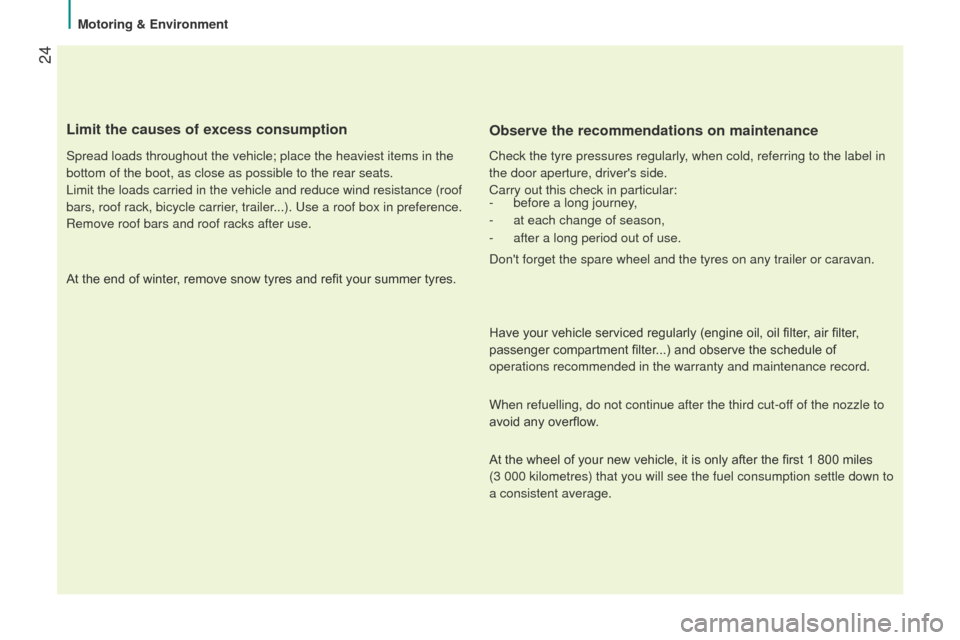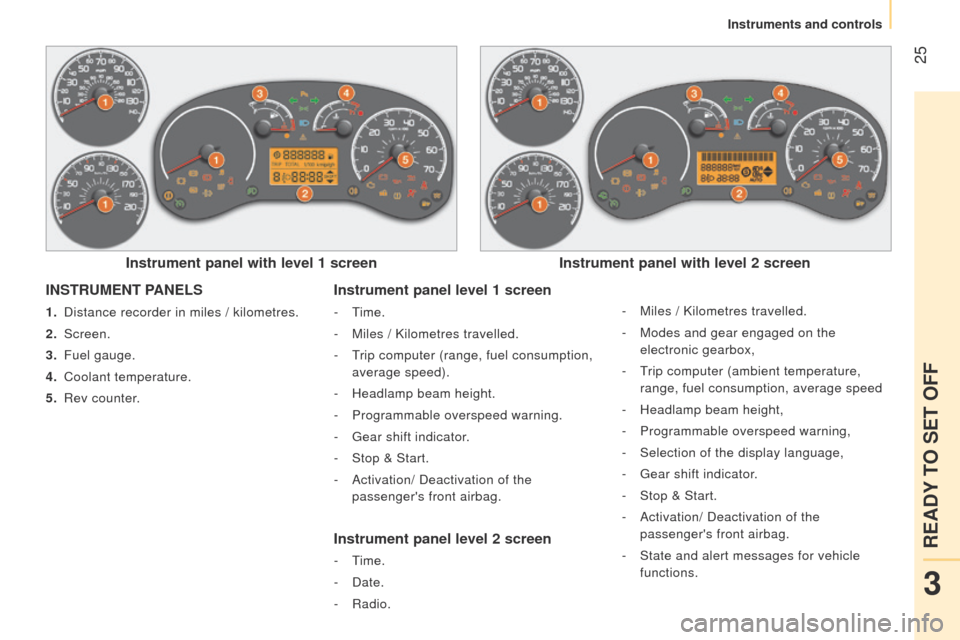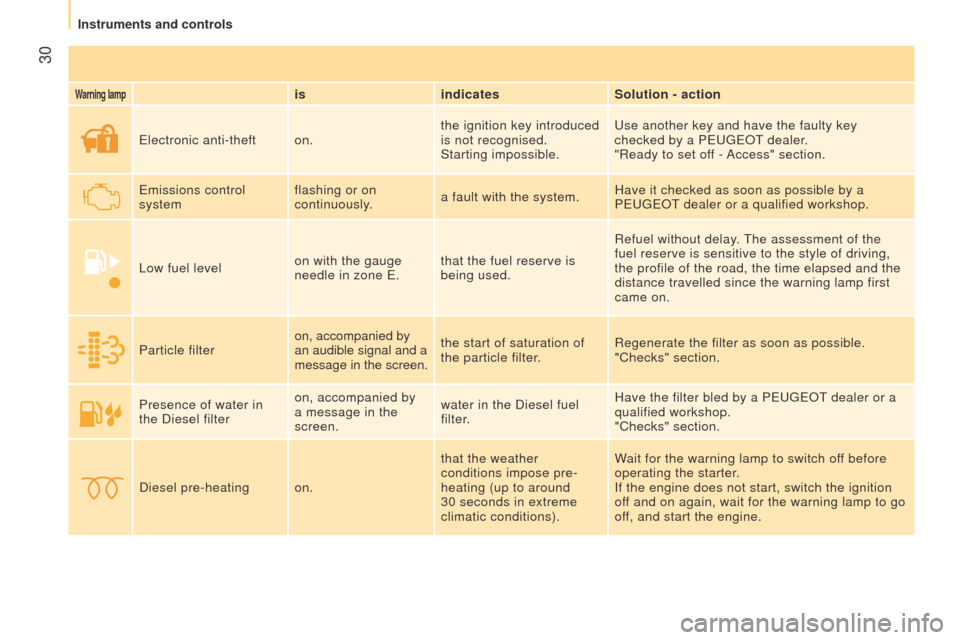2014.5 Peugeot Bipper fuel
[x] Cancel search: fuelPage 4 of 192

2
Bipper_en_Chap00a_sommaire_ed02-2014
EASE OF USE and
COMFORT
4. 64-82 SAFETY
6.
111-136
Front seats 64
Folding front passenger seat
66
Rear bench seat
67
Demisting and defrosting
71
Air conditioning
73
Front fittings
76
Load space fittings
78
Rear fittings
80
Interior lighting - courtesy lamps
82
e
xterior
4
Interior
6
Instruments and controls
12
technical data - Maintenance
16
Dashboard and centre
console
18
OVERVIEW
1.
4-21
Parking brake 1 11
Hazard warning lamps
111
Horn
112
Braking assistance systems
112
trajectory control systems
113
Tyre under-inflation detection
1
16
Seat belts
1
18
Airbags
120
Child seats
124
Deactivating the passenger's front
airbag
127
ISOFIX mountings
134
TECHNOLOGY on
BOARD
5. 83-1
10
Trip computer 83
V ehicle configuration 84
Rear parking sensors
88
Audio equipment
89
Steering mounted controls
90
Bluetooth hands-free system
93
READY TO SET
OFF
3.
25-63
Instrument panels 25
W arning lamps 26
Fuel gauge
34
Coolant temperature
34
Indicator
35
Remote control
36
Key
38
Alarm
40
Opening
41
Closing
44l
ighting stalk
46
Wiper stalk
48
Cruise control
49
Fixed speed limiter
50
Mirrors
51
e
lectric windows
52
Steering wheel adjustment
53
Manual gearbox
53e
lectronic gearbox
54
Gear shift indicator
58
Starting and stopping
59
Hill start assist
60
Stop & Start
61
ECO-DRIVING
2.
22-24
environment 22e
co-driving 23
Contents
Page 5 of 192

3
Bipper_en_Chap00a_sommaire_ed02-2014
TECHNICAL DATA
10.
174-183ACCESSORIES
7.
137-140
towing a trailer ,
caravan, etc... 137
Roof rack and
roof bars
139
Other accessories
139Filling with fuel
142
Opening the bonnet
144
Diesel engine
145
Petrol engine
146l
evels
147
Checks
149
Particle filter
(Diesel)
151
QUICK HELP
9.
152-173
CHECKS
8.
141-151
Battery 152
Changing a wheel 155temporary puncture repair
kit
158
Snow chains
160
Changing a bulb
161
Changing a wiper blade
166
Changing a fuse
167towing the vehicle
172Dimensions
174
Engines
180
W
eights
182
Identification
markings
183
corresponds to a left hand
drive vehicle.
corresponds to a right
hand drive vehicle.
CONteNtS
Contents
Page 6 of 192

4
Bipper_en_Chap01_vue-ensemble_ed02-2014
EXTERIOR (LIGHT VAN)
Rear lamp, direction indicators, 3rd brake lamp ..........46-47, 164-165
Right-hand side:
fuel filler cap, fuel tank
...................
142
fuel cut-off ...............................
142-143
l
oad space
.................................
77-78
Rear doors
............................
36, 42-45
Opening/Closing to 180°
...........
42, 44
Number plate lamps
......................164
Rear parking sensors
......................88
Spare wheel, changing a wheel, tools
..................................... 155-157
towing, lifting .................................172
towbar .................................... 137-13
8
Dimensions
.............................
174-175
Accessories
............................
139-140
Roof rack
.......................................
139
Key, remote control, battery
........
36-38
Central locking
.....................
36, 42, 44
Opening/Closing front windows
....... 37
Confidential card .............................. 39
Alarm
...............................................
40
Wiper blades.................................. 156
Door mirrors
..................................... 51
Side repeater
................................. 163
Front lamps, foglamps,
direction indicators
... 46-47, 161-162
Headlamp beam height adjustment ....... 47
Changing bulbs.......................161-16 5
Opening/Closing doors
........
.................... 36, 38, 41-45
Opening the bonnet
....................... 144
Configuration -
Autoclose
.................... 42, 44, 83, 85 Brakes, pads..........................
147, 149
Hill start assist
.................................60
Braking assistance
.................112-113
trajectory control
....................113-115
tyres, pressures
....................159, 183
Snow chains
..................................160
Location
Page 7 of 192

5
Bipper_en_Chap01_vue-ensemble_ed02-2014
EXTERIOR (COMBI)
Brakes, pads..........................147, 149
Hill start assist ................................. 60
Braking assistance
.................112-113
trajectory control
....................113-115
Under-inflation detection ......... 116-117
tyres, pressures
....................159, 183
Snow chains
.................................. 160
Dimensions
.............
176-177, 178-179
Accessories
............................
139-140
Roof bars
.......................................
139
Key, remote control, battery
........
36-38
Central locking
.....................
36, 42, 44
Opening/Closing front windows
....... 37
Confidential card .............................. 39
Alarm
...............................................
40
Wiper blades.................................. 166
Door mirrors
.....................................
51
Side repeater
................................. 163
Front lamps, foglamps, direction indicators
.................
46-47, 161-162
Headlamp beam height adjustment
....
47
Changing bulbs.......................161-165
Opening/Closing doors
........
.................... 36, 38, 41-45
Child lock
......................................... 45
Rear windows
.................................. 52
Opening the bonnet
....................... 144
Configuration -
Autoclose
.................... 42, 44, 83, 85 Right-hand side:
fuel filler cap, fuel tank
...................
142
fuel cut-off ...............................
142-143
Rear fittings ................................
80-81
Rear doors
............................
36, 42-45
Opening/Closing to 180°
...........
42, 44
Number plate lamps
......................
164
Rear parking sensors
......................
88
Spare wheel, changing a wheel, tools,
temporary puncture
repair kit ...............
155-157, 158-159
towing, lifting ................................. 172
towbar .................................... 137-13
8
Rear lamps, direction indicators,
3
rd brake lamp ..........46-47, 164-165
1
OVERVIEW
Location
Page 25 of 192

23
Bipper_en_Chap02_eco-conduite_ed02-2014
ECO-DRIVING
eco-driving is a range of everyday practices that allow the motorist to o\
ptimise their fuel consumption and CO2 emissions.
Optimise the use of your gearbox
With a manual gearbox, move off gently and change up without
waiting. During acceleration change up early.
With an automatic or electronic gearbox, give preference to automatic
mode and avoid pressing the accelerator pedal heavily or suddenly.
t
he gear shift indicator invites you engage the most suitable gear: as
soon as the indication is displayed in the instrument panel, follow it
straight away.
For vehicles fitted with an electronic or automatic gearbox, this
indicator appears only in manual mode.
Drive smoothly
Maintain a safe distance between vehicles, use engine braking rather
than the brake pedal, and press the accelerator progressively.
t
hese
practices contribute towards a reduction in fuel consumption and CO
2
emissions and also helps reduce the background traffic noise.
If your vehicle has cruise control, make use of the system at speeds
above 25 mph (40 km/h) when the traffic is flowing well.
Control the use of your electrical equipment
Before moving off, if the passenger compartment is too warm, ventilate it
by opening the windows and air vents before using the air conditioning.
Above 30 mph (50 km/h), close the windows and leave the air vents
open.
Remember to make use of equipment that can help keep the
temperature in the passenger compartment down (sunroof and window
blinds...).
Switch off the air conditioning, unless it has automatic regulation, as
soon as the desired temperature is attained.
Switch off the demisting and defrosting controls, if not automatic.
Switch off the heated seat as soon as possible.
Switch off the headlamps and front foglamps when the level of light
does not require their use.
Avoid running the engine before moving off, particularly in winter; your
vehicle will warm up much faster while driving.
As a passenger, if you avoid connecting your multimedia devices
(film, music, video game...), you will contribute towards limiting the
consumption of electrical energy, and so of fuel.
Disconnect your portable devices before leaving the vehicle.
2
ECO-DRIVING
Motoring & Environment
Page 26 of 192

24
Bipper_en_Chap02_eco-conduite_ed02-2014
Limit the causes of excess consumption
Spread loads throughout the vehicle; place the heaviest items in the
bottom of the boot, as close as possible to the rear seats.
l
imit the loads carried in the vehicle and reduce wind resistance (roof \
bars, roof rack, bicycle carrier, trailer...).
u se a roof box in preference.
Remove roof bars and roof racks after use.
At the end of winter, remove snow tyres and refit your summer tyres.
Observe the recommendations on maintenance
Check the tyre pressures regularly, when cold, referring to the label in
the door aperture, driver's side.
Carry out this check in particular:
-
before a long journey
,
-
at each change of season,
-
after a long period out of use.
Don't forget the spare wheel and the tyres on any trailer or caravan.
Have your vehicle serviced regularly (engine oil, oil filter
, air filter,
passenger compartment filter...) and observe the schedule of
operations recommended in the warranty and maintenance record.
When refuelling, do not continue after the third cut-off of the nozzle to
avoid any overflow.
At the wheel of your new vehicle, it is only after the first 1 800 miles
(3
000 kilometres) that you will see the fuel consumption settle down to
a consistent average.
Motoring & Environment
Page 27 of 192

25
Bipper_en_Chap03_pret-a-partir_ed02-2014
INSTRUMENT PANELS
1. Distance recorder in miles / kilometres.
2. Screen.
3.
Fuel gauge.
4.
Coolant temperature.
5.
Rev counter
.
Instrument panel with level 1 screen Instrument panel with level 2 screen
Instrument panel level 1 screen
- time.
-
Miles / Kilometres travelled.
-
t
rip computer (range, fuel consumption,
average speed).
-
Headlamp beam height.
-
Programmable overspeed warning.
-
g ear shift indicator.
-
Stop & Start.
-
Activation/ Deactivation of the
passenger's front airbag.
Instrument panel level 2 screen
- time.
-
Date.
-
Radio. -
Miles / Kilometres travelled.
-
Modes and gear engaged on the
electronic gearbox,
- t
rip computer (ambient temperature,
range, fuel consumption, average speed
-
Headlamp beam height,
-
Programmable overspeed warning,
-
Selection of the display language,
-
g ear shift indicator.
-
Stop & Start.
-
Activation/ Deactivation of the
passenger's front airbag.
- State and alert messages for vehicle
functions.
3
READY TO SET OFF
Instruments and controls
Page 32 of 192

30
Bipper_en_Chap03_pret-a-partir_ed02-2014
Warning lampisindicates Solution - action
e
lectronic anti-theft on.the ignition key introduced
is not recognised.
Starting impossible.
u
se another key and have the faulty key
checked by a P
euge O t
dealer
.
"Ready to set off - Access" section.
e
missions control
system flashing or on
continuously.
a fault with the system. Have it checked as soon as possible by a
P
euge O t
dealer or a qualified workshop.
l
ow fuel level on with the gauge
needle in zone
e .that the fuel reserve is
being used. Refuel without delay.
t
he assessment of the
fuel reserve is sensitive to the style of driving,
the profile of the road, the time elapsed and the
distance travelled since the warning lamp first
came on.
Particle filter on, accompanied by
an audible signal and a
message in the screen.the start of saturation of
the particle filter.
Regenerate the filter as soon as possible.
"Checks" section.
Presence of water in
the Diesel filter on, accompanied by
a message in the
screen.water in the Diesel fuel
filter. Have the filter bled by a P
euge O t
dealer or a
qualified workshop.
"Checks" section.
Diesel pre-heating on.that the weather
conditions impose pre-
heating (up to around
30 seconds in extreme
climatic conditions). Wait for the warning lamp to switch off before
operating the starter.
If the engine does not start, switch the ignition
off and on again, wait for the warning lamp to go
off, and start the engine.
Instruments and controls